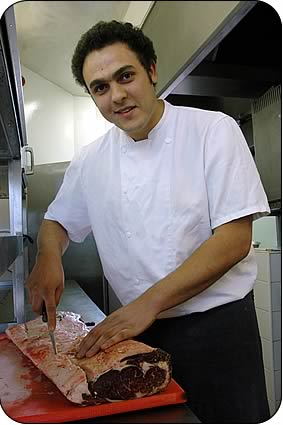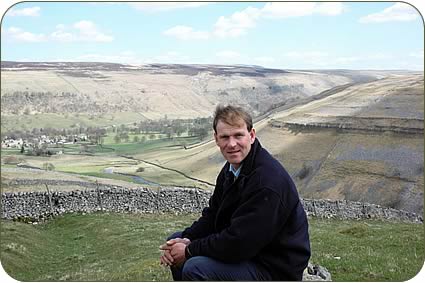Jennifer MacKenzie is an agricultural photo journalist with almost 30 year's experience. Operating from her base in Cumbria, Jennifer undertakes mainly industry-related freelance writing and photography.
Limestone Country Project
A unique initiative aimed at further enhancing part of North Yorkshire’s renowned upland landscape now links the visitor, conservationist, farmer – and the consumer.
The Limestone Country Project was set up to help protect and improve some of England’s most important wildlife sites by promoting the re-introduction of native cattle breeds to graze the limestone pavement areas of Malham and Ingleborough in the Yorkshire Dales National Park.
Three years since its inception the project includes 17 farmers who have received grants to establish herds of eight different native breeds of cattle – and the beef from these cattle is now being marketed as Limestone Beef, generating a premium for the producers involved.
 |
| Behind the Limestone Country Project - back, left to right, Tim Thom, senior wildlife conservation officer of the Yorkshire Dales National Park, Paul Evans, of English Nature , Limestone Beef director Anthony Roberts, butcher Garth Steadman, seated Limestone Beef chairman Jim Caygill and Louise Williams, Limestone Country project officer. |
Although none of the beef has been certified as organic, each animal has been raised on natural grassland that falls within a Special Area of Conservation with producers ultimately having a stringent set of agreed guidelines to work within.
Test marketing of the beef with the involvement of Gargrave food and drink network, Feast, began in 2005 when samples were sent to some of the top chefs in Yorkshire and the first Limestone Beef was served to customers on St George’s Day at the Devonshire Fell hotel in Burnsall near Skipton with a sirloin roasted for guests to mark the official launch of the brand on Thursday April 27th 2006.
Over the next 12 months more than 200 cattle will be available through the scheme and with more farmers joining the scheme the supply will be further increased with up to 1,000 cattle processed each year.
The partnership which involves the national park and English Nature aims to restore the diversity of plant species on almost 2,000 ha of habitat by encouraging farmers to return to mixed grazing with currently 17 herds of traditional upland cattle – considerably in excess of the project’s original target.
 |
| Chef at the Devonshire Fell Mehdi Boukemach prepares the Luing sirloin roast for the launch dinner. |
Tim Thom, of the Yorkshire Dales National Park, said: “Because of the general decline in mixed grazing over the last 40 years, a lot of farmers in the area were almost exclusively running sheep and where they still had cattle they tended to be larger, continental crosses which are very selective in what they graze.
“They were not necessarily grazing the rougher grasses which then take over from the wild herbs and flowers. On a lot of these hill pastures, continental cattle would not thrive and through the project we have been able to bring back grazing to those higher pastures.
“Cattle will also generally stay off the limestone pavements which allows vegetation to grow in the grykes.
“We have negotiated for the agricultural conservation scheme to include supplements for farmers who run traditional breeds of cattle.
“We hope we have demonstrated that farming and nature conservation can work together. We have raised awareness of the need to retain cattle in the uplands.”
Colin Robinson, whose family butcher’s shop in Grassington has been selling beef from the project’s farm’s almost exclusively for the last year using on average three carcases a fortnight, provided the sirloin roast and the smoked beef pastrami starter for Thursday’s dinner. The beef was from John Dean’s Luing herd at Freshfield, Grassington.
Mr Robinson said: “I have always been interested in using local produce and with us being right at the heart of the project area I wanted to use the beef - we’ve never looked back with it.
“The project has been good because of the feedback I can have with the producers. I have had a lot of favourable comments from customers and the brand is selling itself now.
“The extra fat cover is over the hind quarters which adds to the eating quality and the forequarters are good,” said Mr Robinson who hopes to be able to source even more of the beef as it becomes available.
 |
| Richard Paul with the hill where his Welsh Black graze behind him on the right. |
Welsh-born Richard Paul and his wife Sarah, originally from Skipton, chose Welsh Black cattle to run at the 500 acre tenanted Carr Farm, Arncliffe, alongside the flock of 380 pedigree Lleyn sheep.
The Pauls joined the Limestone Country Project in the spring of 2005 and have been marketing beef from their herd under their own brand Littondale Welsh Black Beef, selling it vacuum packed in boxes mostly in the Yorkshire area as well as selling cattle through the Limestone Beef scheme.
“We used to run 45 Limousin cross Belgian Blue cows crossing them with the Limousin and selling the finished bulls at 10 to 11 months old for £500 to £550 and the heifers store at 12 months old for £400 to £450 a head,” said Richard Paul, who works full time as a representative for Farmway in Piercebridge, Darlington, as well as running the farm with his wife.
“However, the change in subsidies with the Single Farm Payment made us think about the future and this led us to buy 25 Welsh Black heifers and join the project.
“When you take the £250 subsidy payment out of the equation it doesn’t leave you a lot of money. Since last October we have sold 17 finished cattle through the box scheme and the project.”
The cattle are finished at around 25 months old and the most grade at R and at minus 04L with carcase weights of 320kg to 350kg.
Cattle for the box scheme are slaughtered, hung for three weeks, cut and vacuum packed for £235 plus vat.
Meat yield is between 180kg and 200kg and the retail value is between £1,100 and £1,200 per carcase compared with a value of around £700 for a Limousin cross finished steer sold through the ring.
All the summer cattle are finished off grass and winter cattle are supplemented with a beef mix. The farm runs from 700ft in the Litton valley up to 1,200ft.
“We have been in the Malham SSSI scheme for 15 years. At one time there used to be many cattle on the hills, especially dairy heifers which were brought onto higher ground to get them away from the flies.
“Without the cattle the vegetation has become long and it has restricted the growth of the wild flowers,” said Mr Paul.
 |
| Neil Heseltine and Belted Galloway in calf heifers due to calve in September. |
Neil Heseltine, of Hilltop Farm, Malham, is the fourth generation of his family to farm in the area.
His parents John and Annie Heseltine last ran a beef herd around 20 years ago when they converted the barn they were housed in to a bunk barn for walkers.
“I had wanted to set up a beef unit that was viable producing qualify beef which would hopefully generate a premium and make beef farming profitable in its own right, rather than relying on subsidies,” said Mr Heseltine.
“I had thought about Belted Galloways and then the Limestone Country Project came about. It was pretty much along the lines of what I had been thinking of doing – everything about the scheme I agree with in terms of its environmental aims.”
He farms 900 acres of LFA land which is all enclosed running from 800ft to 1,800ft above sea level.
As part of the agreement he has reduced his Swaledale flock by 100 ewes to 500, 100 of which are bred pure for flock replacements, in order to run the herd of 19 Belted Galloways and dun Belted Galloway bull he bought two years ago from breeders in Cumbria and Scotland. There is also a flock of 25 pedigree Bluefaced Leicesters.
Three of the yearling heifers he bought have produced calves and he intends to breed the Belties pure, registering the calves and selling surplus females as breeding cattle and finishing the males to go into the project.
“Malham is a tourist area and I aesthetically thought it would be good to re-introduce native cattle to the area,” he said.
“It has allowed me to graze areas which are away from home more easily with the cattle. For the way I wanted to managed the cattle I needed a hardy breed which I could outwinter and the Belted Galloways have only had hay when there has been snow on the ground.
“They are quiet and easily managed. I walk them the four miles to another grazing block of land along an old drove road.
“I don’t expect the cattle to bring in a massive amount of money but it will be on top of what the farm is earning at the moment.”
On-going work with the project includes developing relationships with local abattoirs and building partnerships with local chefs and retailers.
The project received international acknowledgement when it won first prize in the Eurosite Awards 2005, made by a network of European conservation area management.
It has joined a research programme with Defra and Bristol University looking at the healthiness and quality of beef produced from traditional and modern breeds reared on species-rich unimproved grasslands.
Research programmes have also been established by Newcastle University and Askham Bryan College.

